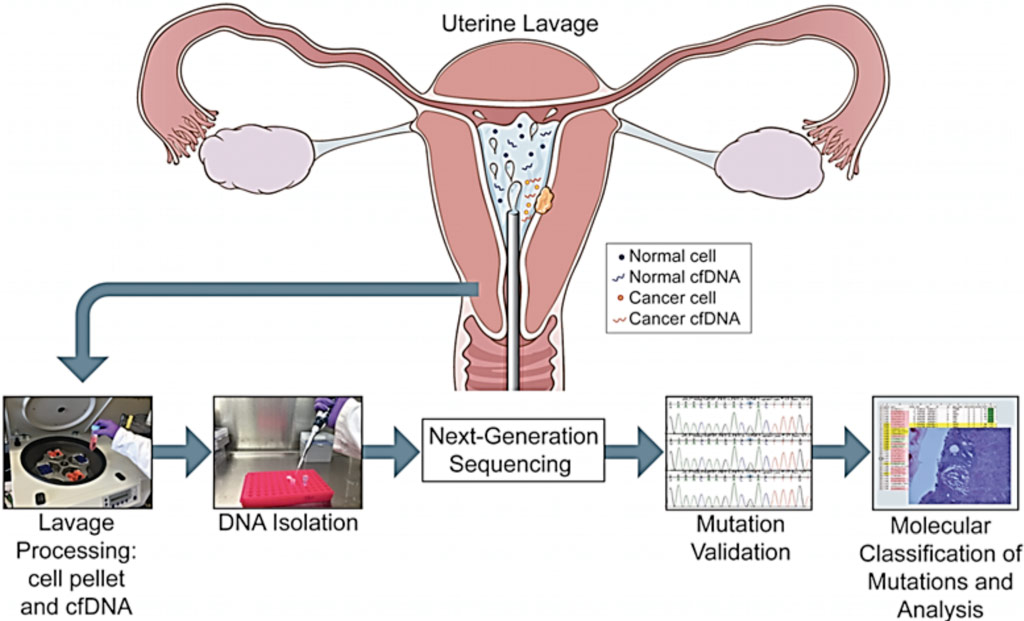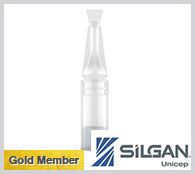Endometrial Cancer Mutations Detected in Uterine Lavage Fluid
|
By LabMedica International staff writers Posted on 11 Jan 2017 |

Image: Overview of the study pipeline beginning with collection of uterine lavage fluid at the initiation of hysteroscopy (Photo courtesy of Icahn School of Medicine at Mount Sinai).
Endometrial cancer is the most common gynecologic malignancy, and its incidence and associated mortality are increasing and despite the immediate need to detect these cancers at an earlier stage, there is no effective screening methodology or protocol for endometrial cancer.
The comprehensive, genomics-based analysis of endometrial cancer has led to the use of ultra-deep, targeted gene sequencing that could detect somatic mutations in uterine lavage fluid obtained from women undergoing hysteroscopy as a means of molecular screening and diagnosis.
A team of scientists at the Icahn School of Medicine at Mount Sinai (New York, NY, USA) and their colleagues collected uterine lavage and paired blood samples from 107 consecutive patients who were undergoing hysteroscopy and curettage for diagnostic evaluation from this single-institution study. The lavage fluid was separated into cellular and acellular fractions by centrifugation. Cellular and cell-free DNA (cfDNA) were isolated from each lavage.
Two targeted next-generation sequencing (NGS) gene panels, one composed of 56 genes and the other of 12 genes, were used for ultra-deep sequencing. To rule out potential NGS-based errors, orthogonal mutation validation was performed using digital polymerase chain reaction (PCR) and Sanger sequencing. In parallel to the genetic study, the hysteroscopy samples were analyzed separately from the advanced genetic workflow using traditional gold-standard classic histopathology methods. DNA sample quantity and integrity were assessed with an ALU repeat qPCR assay (Swift Biosciences, Ann Arbor, MI, USA).
In this prospective study of 107 women, seven were found to have endometrial cancer based upon histopathological evidence and all seven, even those with only microscopic evidence of cancer, had significant cancer-driver gene mutations detected in their uterine lavage fluid, including both the cellular and cell free DNA. Surprisingly, 51 women with no histopathological evidence of cancer also carried cancer-driver mutations in the cells or the cell free DNA from their lavage fluid.
John A. Martignetti, MD, PhD, a professor of Genetics and Genomic Sciences, and a senior author of the study said, “Since a uterine lavage can be easily and quickly performed in a physician's office, our initial idea was that this molecular approach could lead to early detection of pre-cancerous and cancerous conditions of the uterus.” The study was published on December 27, 2016, in the journal Public Library of Science Medicine.
Related Links:
Icahn School of Medicine at Mount Sinai
Swift Biosciences
The comprehensive, genomics-based analysis of endometrial cancer has led to the use of ultra-deep, targeted gene sequencing that could detect somatic mutations in uterine lavage fluid obtained from women undergoing hysteroscopy as a means of molecular screening and diagnosis.
A team of scientists at the Icahn School of Medicine at Mount Sinai (New York, NY, USA) and their colleagues collected uterine lavage and paired blood samples from 107 consecutive patients who were undergoing hysteroscopy and curettage for diagnostic evaluation from this single-institution study. The lavage fluid was separated into cellular and acellular fractions by centrifugation. Cellular and cell-free DNA (cfDNA) were isolated from each lavage.
Two targeted next-generation sequencing (NGS) gene panels, one composed of 56 genes and the other of 12 genes, were used for ultra-deep sequencing. To rule out potential NGS-based errors, orthogonal mutation validation was performed using digital polymerase chain reaction (PCR) and Sanger sequencing. In parallel to the genetic study, the hysteroscopy samples were analyzed separately from the advanced genetic workflow using traditional gold-standard classic histopathology methods. DNA sample quantity and integrity were assessed with an ALU repeat qPCR assay (Swift Biosciences, Ann Arbor, MI, USA).
In this prospective study of 107 women, seven were found to have endometrial cancer based upon histopathological evidence and all seven, even those with only microscopic evidence of cancer, had significant cancer-driver gene mutations detected in their uterine lavage fluid, including both the cellular and cell free DNA. Surprisingly, 51 women with no histopathological evidence of cancer also carried cancer-driver mutations in the cells or the cell free DNA from their lavage fluid.
John A. Martignetti, MD, PhD, a professor of Genetics and Genomic Sciences, and a senior author of the study said, “Since a uterine lavage can be easily and quickly performed in a physician's office, our initial idea was that this molecular approach could lead to early detection of pre-cancerous and cancerous conditions of the uterus.” The study was published on December 27, 2016, in the journal Public Library of Science Medicine.
Related Links:
Icahn School of Medicine at Mount Sinai
Swift Biosciences
Latest Molecular Diagnostics News
- Respiratory Panel to Help Clinicians Make Precise Treatment Decisions in Outpatient Settings
- Integrating Cardiovascular Risk Biomarkers Aids in Detection of ‘Inflammaging’
- Genetic Signature in Newborns Predicts Neonatal Sepsis Before Symptoms Appear
- Integrating Multiple Protein Markers Predicts Health Outcomes in Chronic Kidney Disease Patients
- Rapid Finger Prick Blood Test to Detect Active Syphilis at Point of Care
- Urine Tests Could Reveal Early Signs of Cancer and Other Diseases
- AI-Powered Smart PCR System to Revolutionize Clinical Diagnostics
- Simple Blood Test Identifies Women in Labor at Risk for Preeclampsia
- Point-Of-Care Paper-Based Test Could Diagnose Cancer at Bedside
- Sepsis Test Demonstrates Clinical Utility in Critically Ill Heterogeneous Patient Populations
- Multi-Cancer Early Detection Test Measures Host Response to Tumor Development
- MicroRNA-Based Test Identifies 12 Cancers Simultaneously Across Any Stage
- New Blood Test Platform Simultaneously Measures Over 100 Biomarkers of Alzheimer's Disease

- First-Ever Blood Test Diagnoses Maternal Autoantibody Related Autism
- Precision Medicine Blood Test Predicts Heart Disease Before It Occurs
- Blood-Based PCR Test Guides Alzheimer's Therapy
Channels
Clinical Chemistry
view channel.jpg)
POC Saliva Testing Device Predicts Heart Failure in 15 Minutes
Heart failure is a serious condition where the heart muscle is unable to pump sufficient oxygen-rich blood throughout the body. It ranks as a major cause of death globally and is particularly fatal for... Read more
Screening Tool Detects Multiple Health Conditions from Single Blood Drop
Infrared spectroscopy, a method using infrared light to study the molecular composition of substances, has been a foundational tool in chemistry for decades, functioning similarly to a molecular fingerprinting... Read more
Integrated Chemistry and Immunoassay Analyzer with Extensive Assay Menu Offers Flexibility, Scalability and Data Commutability
As global healthcare systems increasingly shift towards networked laboratory operational models to enhance efficiency and patient access, there is a greater need for innovative solutions tailored to the... Read moreHematology
view channel
Next Gen CBC and Sepsis Diagnostic System Targets Faster, Earlier, Easier Results
Every hour is critical in protecting patients from infections, yet there are currently limited tools to assist in early diagnosis before patients reach a hospital. The complete blood count (CBC) is a common... Read more
Newly Discovered Blood Group System to Help Identify and Treat Rare Patients
The AnWj blood group antigen, a surface marker discovered in 1972, has remained a mystery regarding its genetic origin—until now. The most common cause of being AnWj-negative is linked to hematological... Read more
Blood Platelet Score Detects Previously Unmeasured Risk of Heart Attack and Stroke
Platelets, which are cell fragments circulating in the blood, play a critical role in clot formation to stop bleeding. However, in some individuals, platelets can become "hyperreactive," leading to excessive... Read moreImmunology
view channel
Computational Tool Predicts Immunotherapy Outcomes for Metastatic Breast Cancer Patients
Immunotherapy aims to enhance the body’s immune response to target cancer cells, but not all patients experience a positive reaction to such treatments. Identifying which patients will benefit from immunotherapy... Read more
Biomarker Could Predict Immunotherapy Response in Liver Cancer
Until recently, patients diagnosed with hepatocellular carcinoma had limited treatment options, with existing therapies extending life by only a few months. Immunotherapy has emerged as a new alternative... Read more
Epigenetic Test Could Determine Efficacy of New Immunotherapy Treatments Against Multiple Myeloma
Multiple myeloma is a blood cancer that primarily affects individuals over the age of sixty, and its occurrence rises as the population ages. In this disease, the bone marrow—the spongy tissue inside bones... Read moreMicrobiology
view channel
High-Accuracy Bedside Test to Diagnose Periprosthetic Joint Infection in Five Minutes
Periprosthetic joint infection (PJI) represents a significant global issue that is worsening as the number of joint replacements increases due to aging populations. In the United States alone, the anticipated... Read more_1.jpg)
Innovative Diagnostic Approach for Bacterial Infections to Enable Faster and Effective Treatment
For patients with bacterial infections, timely treatment with the appropriate antibiotics significantly improves their chances of recovery. Current methods for identifying which antibiotics will be effective... Read more
Non-Invasive Stool Test to Diagnose Endometriosis and Help Reduce Disease Progression
Endometriosis, a painful condition impacting nearly 200 million women globally, occurs when tissue similar to the lining of the uterus grows outside its usual location, such as on the intestines or the... Read more
Automated Positive Blood Culture Sample Preparation Platform Designed to Fight Against Sepsis and AMR
Delayed administration of antibiotics to patients with bloodstream infections significantly increases the risk of morbidity and mortality. For optimal therapeutic outcomes, it is crucial to rapidly identify... Read morePathology
view channel
New Imaging Method Opens Door to Precision Diagnostics for Head and Neck Cancers
Head and neck cancers, while considered rare, represent a significant portion of cancer cases and have seen a notable increase over the past 30 years. These cancers encompass various malignant tumors that... Read more
Faster Measurement of Vibrational Fingerprint of Molecules to Advance Biomedical Diagnostics
Identifying different types of molecules and cells is a vital process in both basic and applied science. Raman spectroscopy serves as a widely utilized measurement technique for this purpose.... Read moreTechnology
view channel
New Noninvasive Methods Detect Lead Exposure Faster, Easier and More Accurately at POC
Exposure to lead can negatively affect health in multiple ways, leading to damage in the brain and central nervous system, delays in development and growth, learning and behavioral issues, problems with... Read more
Noninvasive Test Detects Malaria Without Blood Sample
Malaria remains a significant global health issue, with approximately 250 million cases and over 600,000 deaths reported annually. Nearly half of the world's population is at risk for malaria infection,... Read moreIndustry
view channel
Beckman Coulter Partners with BioPorto for Global Distribution of Acute Kidney Injury NGAL Tests
Acute kidney injury (AKI) is a sudden episode of kidney failure or damage that can occur within a few hours or days. This condition leads to the accumulation of waste products in the blood and disrupts... Read more_1.jpg)
CACLP 2025 New Date and Venue Announced
The 22nd China International In Vitro Diagnostic Expo, organized by the China Association of Clinical Laboratory Practice Expo (CACLP, Shanghai, China), is set to take place from March 21 to 24, 2025,... Read more
Roche to Develop New Diagnostic Technologies for Traumatic Brain Injuries
Traumatic brain injuries (TBI) represent a significant global health issue, affecting approximately 69 million people each year. TBI occurs when an external force disrupts normal brain function, with severity... Read more
















